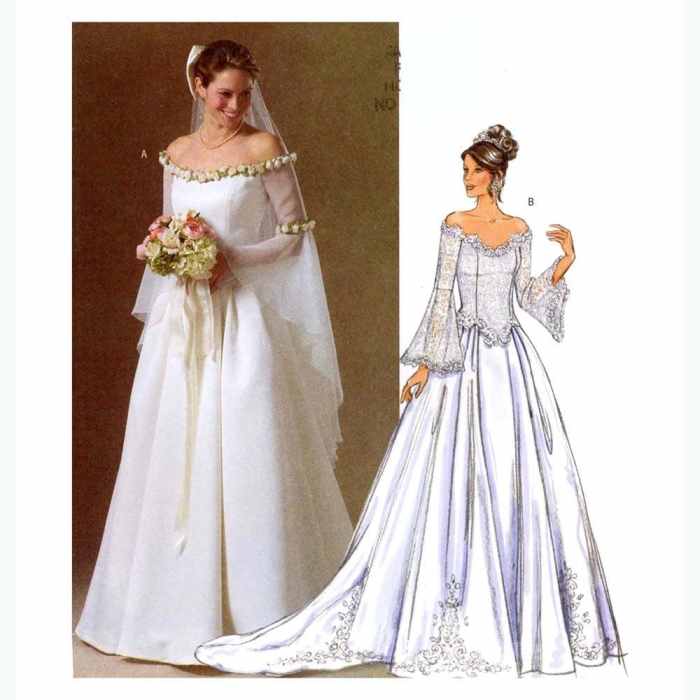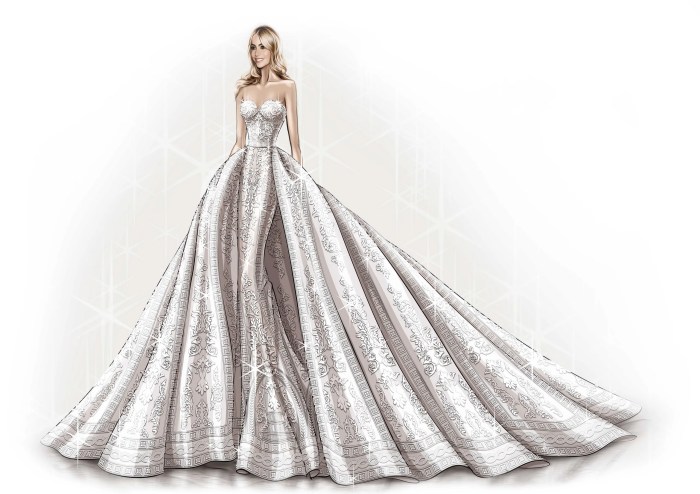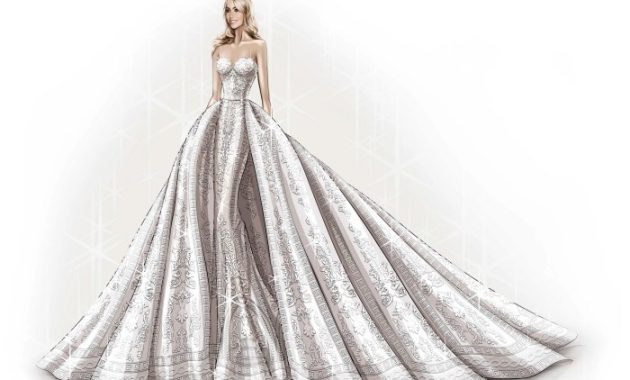Types of Wedding Dresses
Collection of wedding dresses – Choosing a wedding dress is a significant decision, influenced by personal style, body type, and the overall wedding theme. Understanding the various styles available is crucial for finding the perfect gown. This section explores different dress types, their characteristics, and price ranges, along with examples from various decades.
Wedding Dress Styles Comparison
| Style | Silhouette | Fabric Suitability | Typical Price Range |
|---|---|---|---|
| A-line | Fitted at the bodice, flaring gently from the waist | Lace, chiffon, satin, crepe | $1,000 – $5,000+ |
| Ballgown | Fitted bodice with a full, voluminous skirt | Tulle, organza, silk taffeta | $1,500 – $10,000+ |
| Mermaid | Fitted through the hips and flares out dramatically at the knees | Silk, satin, crepe, lace | $1,500 – $8,000+ |
| Sheath | Straight, close-fitting silhouette | Crepe, satin, jersey | $800 – $4,000+ |
Wedding Dress Collections by Decade
Wedding dress styles have evolved significantly over the decades, reflecting the fashion trends of each era. The following provides a glimpse into some key design features.
- 1920s: Characterized by dropped waistlines, loose silhouettes, and embellishments like beading and fringe. Think flapper-inspired designs with a sense of effortless elegance.
- 1950s: Defined by full skirts, cinched waists, and a romantic, feminine aesthetic. Think classic Hollywood glamour with sweetheart necklines and delicate lace.
- 1980s: Bold and dramatic, often featuring large sleeves, structured silhouettes, and elaborate details like ruffles and bows. Think princess-inspired gowns with a touch of extravagance.
- Modern: A diverse range of styles, from minimalist and sleek designs to bohemian-inspired lace gowns and modern interpretations of classic silhouettes. Think clean lines, innovative fabrics, and personalized details.
Designer vs. Affordable Wedding Dresses, Collection of wedding dresses
The price difference between designer and more affordable wedding dresses stems from several factors, including the designer’s reputation, the quality of materials used, the intricacy of the design, and the manufacturing process. Designer dresses often feature unique details, luxurious fabrics, and meticulous craftsmanship.
Fabric and Materials
The choice of fabric significantly impacts the look, feel, and price of a wedding dress. Understanding fabric properties is crucial for selecting a gown that suits the wedding style and the bride’s preferences.
Fabric Properties and Examples
Various fabrics offer unique qualities in terms of drape, texture, and care. Some examples include:
- Silk: Luxurious, with a beautiful drape and sheen. Requires professional cleaning.
- Satin: Smooth, lustrous fabric with a subtle sheen. Relatively easy to care for.
- Lace: Delicate, intricate fabric with a romantic feel. Requires careful handling and cleaning.
- Tulle: Lightweight, sheer netting often used for creating volume in skirts. Easy to care for.
Innovative and Unique Materials
High-end designers often incorporate innovative materials like hand-dyed silks, embroidered organza, or recycled fabrics to create unique and sustainable wedding dresses. These materials can significantly impact both the design and the cost of the gown.
Common Embellishments
Embellishments add detail and visual interest to wedding dresses. Some common examples are:
- Beading: Adds sparkle and texture, ranging from subtle to extravagant.
- Embroidery: Creates intricate patterns and designs, adding a touch of artistry.
- Appliqués: Decorative elements sewn onto the fabric, adding dimension and detail.
Wedding Dress Collection Design and Inspiration
Wedding dress designers draw inspiration from a variety of sources to create unique and captivating collections. Understanding these influences provides insight into the creative process and the resulting designs.
Design Inspiration Sources
Designers often look to historical periods, nature, art, and current fashion trends for inspiration. For example, a collection might be inspired by the romanticism of the Victorian era, the flowing lines of nature, or the bold colors of a particular art movement.
Curating a collection of wedding dresses often involves considering a wide range of styles and colors. However, a frequent question arises regarding guest attire, specifically, “can I wear a black dress to a wedding?”, which is easily answered by checking this helpful guide: can i wear black dress to wedding. Understanding guest etiquette helps complete the picture when building a comprehensive collection that accounts for various wedding scenarios.
Famous Wedding Dress Designers and Styles
Many renowned designers have significantly impacted the wedding dress industry, each with their own signature style. Vera Wang, known for her elegant and modern designs, and Oscar de la Renta, celebrated for his romantic and luxurious gowns, are prime examples.
Conceptual Wedding Dress Collection: Bohemian Chic
A bohemian-chic collection would feature flowing silhouettes, natural fabrics like lace and cotton, and earthy tones. Key design elements would include intricate embroidery, delicate beading, and relaxed, unstructured designs.
Marketing and Presentation of Wedding Dress Collections: Collection Of Wedding Dresses

Source: etsystatic.com
Effectively showcasing a wedding dress collection requires a multi-faceted approach, combining various marketing and presentation methods to reach the target audience.
Methods for Showcasing Collections
Fashion shows, lookbooks, and online platforms are all effective ways to present wedding dress collections. Fashion shows offer a dynamic and immersive experience, while lookbooks provide a curated selection of images and details. Online platforms, such as websites and social media, allow for broader reach and accessibility.
Effective Marketing Strategies
Effective marketing strategies for wedding dress collections often target specific demographics and utilize targeted advertising, social media campaigns, and influencer collaborations to reach potential brides.
Mock-up Webpage: “Enchanted Garden” Collection
Imagine a webpage showcasing the “Enchanted Garden” collection, featuring gowns in soft pastels and floral appliqués. Each dress would have high-quality images, detailed descriptions, and key features highlighted using blockquotes.
- Dress 1: “Willow” Gown: A flowing A-line gown in ivory silk chiffon with delicate floral embroidery.
Features a V-neckline, illusion sleeves, and a chapel-length train.
- Dress 2: “Rose” Gown: A fitted mermaid gown in blush pink satin with intricate beading.
Features a sweetheart neckline, a dramatic train, and delicate beading along the bodice.
Sustainability and Ethical Considerations
Increasingly, brides are seeking wedding dresses that align with their values of sustainability and ethical production. This section explores the growing movement towards eco-friendly and ethically sourced wedding attire.
Sustainable Materials and Practices
Sustainable materials like organic cotton, recycled fabrics, and plant-based dyes are becoming increasingly popular in eco-friendly wedding dress collections. These materials reduce the environmental impact of production and promote responsible resource management.
Ethical Sourcing and Manufacturing
Ethical considerations extend to fair labor practices, safe working conditions, and transparent supply chains. Choosing brands committed to ethical sourcing ensures that the wedding dress is produced responsibly and without exploitation.
Brands Committed to Sustainability and Ethics

Source: vogue.com
Several brands and designers are leading the way in sustainable and ethical wedding dress production. These companies often prioritize transparency, fair wages, and eco-friendly materials in their manufacturing processes.
Frequently Asked Questions
What is the average lifespan of a wedding dress?
With proper care and storage, a wedding dress can last for many years, even decades. However, the condition will depend on the fabric and how well it’s maintained.
How should I clean my wedding dress after the wedding?
Professional dry cleaning is recommended to preserve the dress’s condition. Avoid attempting to clean it yourself, as this could damage delicate fabrics.
Where can I find vintage or pre-owned wedding dresses?
Online marketplaces, consignment shops specializing in bridal wear, and even some antique stores offer a selection of vintage and pre-owned wedding dresses.
What are some common alterations needed for wedding dresses?
Common alterations include hemming, taking in the waist or bust, adjusting straps, and adding or removing sleeves. A professional seamstress can provide guidance.

